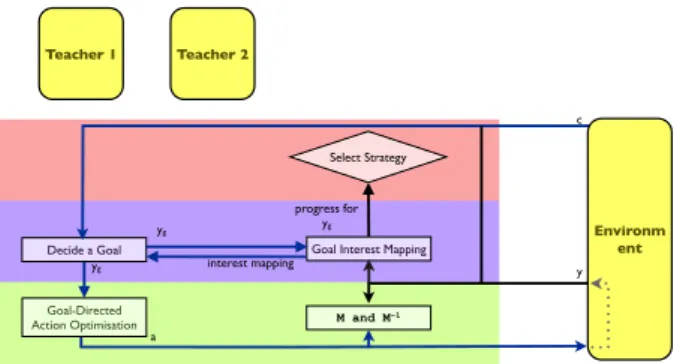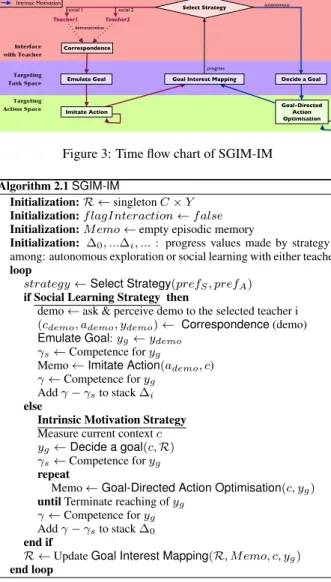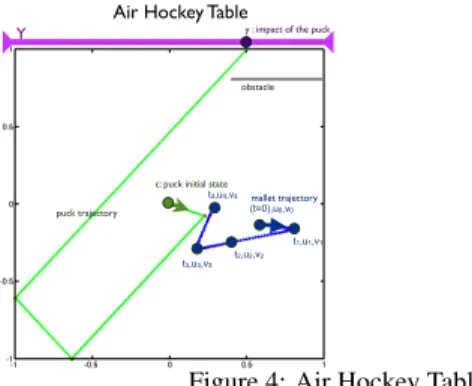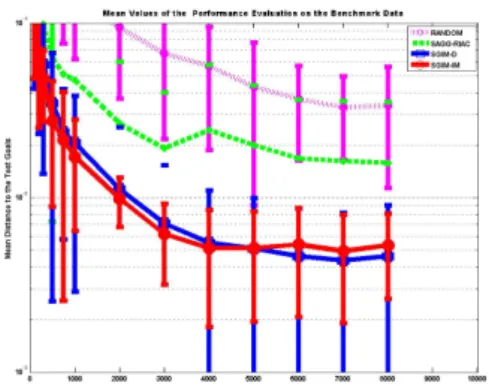HAL Id: hal-00762762
https://hal.inria.fr/hal-00762762
Submitted on 7 Dec 2012
HAL is a multi-disciplinary open access
archive for the deposit and dissemination of
sci-entific research documents, whether they are
pub-lished or not. The documents may come from
teaching and research institutions in France or
abroad, or from public or private research centers.
L’archive ouverte pluridisciplinaire HAL, est
destinée au dépôt et à la diffusion de documents
scientifiques de niveau recherche, publiés ou non,
émanant des établissements d’enseignement et de
recherche français ou étrangers, des laboratoires
publics ou privés.
Whom Will an Intrinsically Motivated Robot Learner
Choose to Imitate from?
Sao Mai Nguyen, Pierre-Yves Oudeyer
To cite this version:
Sao Mai Nguyen, Pierre-Yves Oudeyer. Whom Will an Intrinsically Motivated Robot Learner Choose
to Imitate from?. Post-Graduate Conference on Robotics and Development of Cognition:
RobotDoC-PhD 2012, Sep 2012, Lausanne, Switzerland. �hal-00762762�
Whom Will an Intrinsically Motivated Robot Learner Choose to Imitate from?
Sao Mai Nguyen, Pierre-Yves Oudeyer
1
Flowers Team, INRIA and ENSTA ParisTech, France.
nguyensmai at gmail.com, pierre-yves.oudeyer at inria.fr
Abstract
This paper studies an interactive learning system that couples internally guided learning and social interaction in the case it can interact with several teachers. Socially Guided Intrinsic Motivation with Interactive learning at the Meta level (SGIM-IM) is an algorithm for robot learning of motor skills in high-dimensional, continuous and non-preset environments, with two levels of active learning: SGIM-IM actively decides at a meta-level when and to whom to ask for help; and an active choice of goals in autonomous exploration. We illustrate through an air hockey game that SGIM-IM efficiently chooses the best strat-egy.
Index Terms: Active Learning, Intrinsic Motivation, Social Learning, Programming by Demonstration, Imitation.
1. Introduction
In initial work to address multi-task learning, we proposed the Socially Guided Intrinsic Motivation by Demonstration (SGIM-D) algorithm which merges socially guided exploration as de-fined in[1, 2, 3, 4] and intrinsic motivation [5, 6, 7, 8] based on SAGG-RIAC algorithm [9], to reach goals in a continuous task space, in the case of a complex, high-dimensional and con-tinuous environment [10]. Nevertheless, the SGIM-D learner uses demonstrations given by a teacher at regular frequency. It is passive with respect to the social interaction and the teacher, and does not optimise the timing of the interactions with the teacher, not to mention that it did not consider the everyday situation where it has several human teachers around him, to whom it can ask for help. Some works have considered the choice among the different teachers that are available to be ob-served [11] where some of them might not even be cooperative [12], but have then overlooked autonomous exploration. Our new SGIM-IM (Socially Guided Intrinsic Motivation with In-teractive learning at the Meta level) learner is able to choose between active autonomous and social learning strategies, and in the case of social learning, whom to imitate from.
2. General Framework
2.1. Formalisation
In this subsection, we describe the learning problem that we consider. Csibra’s theory of human action finds that infants connect actions to both their antecedents and their consequents [13, 14]. Thus, every episode would be described as [con-text][action][effect].
Let us describe different aspects of the states of a robotic system and its environment by both a state/context space C, and an effect/task space Y (an effect/task can be considered as re-stricted to the changes caused by the agent’s actions). For given contexts c ∈ C, actions act ∈ ACT allow a transition towards new states y ∈ Y (fig. 1 and 2). We define the actions act as parameterised dynamic motor primitives, i.e. temporally
ex-Goal Interest Mapping
M and M-1 Decide a Goal Goal-Directed Action Optimisation yg interest mapping a yg
SGIM-IM 2 teachers data flow: autonomous mode
progress for yg Select Strategy Environm ent y c Teacher 1 Teacher 2
Figure 1: Data Flow under the Intrinsic Motivation strategy
Imitate Action
Goal Interest Mapping ydemo Emulate Goal Teacher 1 a ademo y ydemo demonstration M and M-1 Environm ent
SGIM-IM 2 teachers data flow: social learning mode
Select Strategy progress for ydemo Correspondence c request demo Teacher 2
Figure 2: Data Flow under the Social Learning strategy with teacher 1
tended macro-actions controlled by parameters a in the action parameters space A. The association (c, a, y) corresponds to a learning exemplar that will be memorised. Our agent learns a policy through an inverse model M−1: (c, y) 7→ a by building local mappings of M : (c, a) 7→ y, so that from a context c and for any achievable effect y, the robot can produce y with an ac-tion a. We can also describe the learning in terms of tasks, and consider y as a desired task or goal which the system reaches through the means a in a given context c. In the following, both descriptions will be used interchangeably.
2.2. SGIM-IM Overview
SGIM-IM learns by episodes during which it chooses actively its learning strategy between intrinsically motivated exploration or social interaction with each of the existing teachers.
In an episode under the intrinsic motivation strategy (fig. 1), it actively generates a goal yg ∈ Y of maximal competence
improvement, then explores which actions a can achieve the goal ygin context c, following the SAGG-RIAC algorithm [9].
The exploration of the action space gives a local forward model M : (c, a) 7→ y and inverse model M−1 : (c, y) 7→ a, that it can use later on to reach other goals. The SGIM-IM learner ex-plores preferentially goals where it makes progress the fastest. It tries different actions to approach the self-determined goal, re-using and optimising the action repertoire of its past
au-Teacher1 Imitate Action Decide a Goal Goal-Directed Action Optimisation Goal Interest Mapping
Interface with Teacher Targeting Task Space Targeting Action Space autonomous social 1 demonstration Intrinsic Motivation Social Learning Emulate Goal SGIM-IM 2 teachers Correspondence Select Strategy progress Teacher2 social 2
Figure 3: Time flow chart of SGIM-IM
Algorithm 2.1SGIM-IM
Initialization: R ← singleton C × Y Initialization: f lagInteraction ← f alse Initialization: M emo ← empty episodic memory
Initialization: ∆0, ...∆i, ... : progress values made by strategy i
among: autonomous exploration or social learning with either teacher loop
strategy ←Select Strategy(prefS, prefA)
if Social Learning Strategy then
demo ← ask & perceive demo to the selected teacher i
(cdemo, ademo, ydemo) ← Correspondence (demo)
Emulate Goal: yg← ydemo
γs← Competence for yg
Memo ← Imitate Action(ademo, c)
γ ← Competence for yg
Add γ − γsto stack ∆i
else
Intrinsic Motivation Strategy Measure current context c
yg← Decide a goal(c, R)
γs← Competence for yg
repeat
Memo ← Goal-Directed Action Optimisation(c, yg)
until Terminate reaching of yg
γ ← Competence for yg
Add γ − γsto stack ∆0
end if
R ← Update Goal Interest Mapping(R, M emo, c, yg)
end loop
tonomous exploration or the actions suggested by the teacher’s demonstrations of the social learning strategy. The episode ends after a fixed duration.
In an episode under the social learning strategy with teacher i (fig. 2), our SGIM-IM learner observes the demonstration [cdemo, actdemo, ydemo], memorise this effect ydemoas a
pos-sible goal, and imitates the demonstrated action actdemofor a
fixed duration.
The SGIM-IM learner actively decides on a meta level which strategy to choose according to the recent learning progress enabled by each strategy. If it has recently made the most progress in the intrinsic motivation strategy, it prefers ex-ploring autonomously. Conversely, if the demonstrations does not enable him to make progresses higher than by autonomous learning (limited teacher, or inappropriate teacher) it would pre-fer autonomous exploration.
3. SGIM-IM Architecture
3.1. A Hierarchical Architecture
SGIM-IM (Socially Guided Intrinsic Motivation with Interac-tive learning at the Meta level) is an algorithm that merges in-teractive learning as social interaction, with the SAGG-RIAC algorithm of intrinsic motivation [9], to learn local inverse and forward models in complex, redundant, high-dimensional and
Algorithm 3.2[strategy] = SelectStrategy(∆S, ∆A)
input: ∆0, ...∆i, ... : progress values made by strategy i
among: autonomous exploration or social learning with ei-ther teacher
output: f lagInter : chosen strategy
parameter: nbM in : duration of the initiation phase parameter: ns : window frame for monitoring progress parameter: costi: cost of each strategy
Initiation phase
if Social Learning and Intrinsic Motivation Regimes have not been chosen each nbM in times yet then
pi← 0.5
else
Permanent phase for all strategies do
wi← average(last ns elements of ∆i)
end for
pi← min(0.9, max(0.1,P costcosti×wi
j×wj))
end if
strategy ← i with probability pi
return strategy
continuous spaces and with several teachers. Its architecture (alg. 2.1) is separated into three layers (fig. 3) :
• An interface with the teacher, which manages the inter-action with the teacher. It decides in an active manner whether to request a demonstration and to whom (Select Strategy) and interpreting his actions or his intent and translates the demonstrations into the robot’s represen-tation system (Correspondence, which is an important issue [15] but will not be addressed in this study. • The Task Space Exploration, a level of active learning
which drives the exploration of the task space. With the autonomous learning strategy, it sets goals ygdepending
on the interest level of previous goals, by stochastically choosing the ones for which its empirical evaluation of learning progress is maximal (Decide a Goal). With the social learning strategy, it retrieves from the teacher in-formation about demonstrated effects ydemo(Emulate a
Goal). Then, it maps C × Y in terms of interest level (Goal Interest Mapping).
• The Action Space Exploration, a lower level of learning that explores the action space A to build an action reper-toire and local models. With the social learning strategy, it imitates the demonstrated actions actdemo, by
repeat-ing it with small variations (Imitate an Action). Durrepeat-ing self-exploration, the Goal-Directed Action Optimisation function attempts to reach the goals yg set by the Task
Space Explorationlevel, 1) by building local models dur-ing exploration that can be re-used for later goals and 2) by optimising actions to reach yg. Then, the Action
Space Explorationreturns the measure of competence at reaching ydemoor yg.
The active choice of learning strategy will be described hereafter. For the other parts of the architecture, which are com-mon to SGIM-D, please refer to [10] for more details.
3.2. Select Strategy
Based on the recent progress made by each of them, a meta level chooses the best strategy among autonomous exploration and social learning with each of the teachers. For each episode,
Y
c: puck initial state puck trajectory
y : impact of the puck
obstacle
mallet trajectory Air Hockey Table
(t=0),u0,v0
t1,u1,v1
t3,u3,v3
t4,u4,v4
t2,u2,v2
Figure 4: Air Hockey Table
the learner measures its progress as the difference of compe-tence at the beginning and the end of the exploration for the self-determined or the emulated goal, and adds this progress value to stacks ∆i, where i is the current strategy (i = 0 for
autonomous exploration, i = 1 for social learning with teacher 1, i = 2 with teacher 2,...). The preference for each strategy is computed as the average on a window frame of the last ns progress values of ∆i. Setting the value of nsdoes not depend
on the complexity of the tasks but more on the size of the task space. It needs to allow appropriate sampling of Y by each method. In our simulations, ns = 20. Besides, to limit the
reliance on the teacher and take into account the availability of each teacher, we penalise the preference for social learning with a costifactor (costi = 100). For the autonomous exploration
strategy, cost0 = 1. The strategies are selected stochastically
with a probability proportional to their preference (alg 3.2). We applied our hierarchical SGIM-IM algorithm with 2 layers of active learning to an illustration experiment.
4. AirHockey Experiment
4.1. Description of the Experimental Setup
Our first experimental setup is a simulated square air hockey ta-ble that contains an obstacle (fig. 4). Starting with a fixed posi-tion and velocity (1 single context), the puck moves in straight line without friction. The effect is the position of the impact when the puck collides with the top border of the table. Y is thus the top border of the table, mapped into the [−1, 1] seg-ment, which highlights the subregion hidden by the obstacle as difficult to reach.
We control our mallet with a parameterised trajectory de-termined by 5 key positions u0, u1, u2, u3, u4 ∈ [−1, 1]2 (10
scalar parameters) at times t0 = 0 < t1 < t2 < t3 < t4(4
parameters). The trajectory in time is generated by Gaussian distance weighting: u(t) = 5 X i=0 wi(t)ui P5 j=0wj(t) with wi(t) = eσ∗|t−ti |2 , σ > 0 (1)
Therefore, A is of dimension 14 and Y of dimension 1. The learner maps which trajectory of the mallet a induces a collision with the top border at position y. This is an inverse model of a highly redundant mapping, which is all the more interesting than the obstacle introduces discontinuities in the model.
4.2. Experimental Protocol
We detail in this subsection the experiments we carry with our air hockey table, how we processed to evaluate SGIM-IM and provide our learner with demonstrations.
Figure 5: Comparison of several learning algorithms 4.2.1. Comparison of Learning Algorithms
To assess the efficiency of SGIM-IM, we decide to compare the performance of several learning algorithms (fig. 5):
• Random exploration: throughout the experiment, the robot picks actions randomly in the action space A. • SAGG-RIAC: throughout the experiment, the robot
ex-plores autonomously driven by intrinsic motivation. It ignores any demonstration by the teacher.
• SGIM-IM: interactive learning where the robot learns by actively choosing between social learning strategy or in-trinsic motivation strategy, and who to imitate from. • SGIM-D: the robot’s behaviour is a mixture between
Im-itation learning and SAGG-RIAC. When the robot sees a new demonstration, it imitates the action for a short while. Then, it resumes its autonomous exploration, un-til it sees a new demonstration by the teacher. Demon-strations occur every T actions of the robot.
For each experiment in our air hockey setup, we let the robot perform 10000 actions in total, and evaluate its perfor-mance every 1000 actions. For the air hockey experiment, we set the parameters of SGIM-IM to: cost = 10 and ns = 20, and those of SGIM-D to T= 50.
4.2.2. Demonstrations and Evaluation
We simulate 2 teachers by using the learning exemplars taken from Random and SAGG-RIAC learners. For teacher 1, we choose demonstrations in [−1, 0.5] with each ydemok∈ [−1 +
k×0.01, −1+(k+1)×0.01]. For teacher 2, we likewise choose demonstrations in [0.5, 1], that manage to place the puck behind the obstacle.
We assess the algorithms by measuring how close they can reach a benchmark set distributed over Y = [−1, 1] and placed every 0.05, with the mean error at reaching the benchmark points.
4.3. Results
Fig.6 plots the mean distance error of the attempts to hit the bor-der at the benchmark points, with respect to the number of ac-tions performed by the mallet. It shows that while Random ex-ploration and SAGG-RIAC error decrease, SGIM-IM performs significantly better, and faster. It almost divided by a factor of 10 the final error value compared to SAGG-RIAC. Its error rate is always smaller than for the other algorithms since the very beginning. SGIM-IM has taken advantage of the demonstra-tions very fast to be able to hit the puck and place it on the top border, instead of making random movements which would have little probability of hitting the puck, let alone placing it at the benchmark position. Its performance is comparable with SGIM-D. This shows that its active choice of strategy was able to choose social learning over autonomous learning to bootstrap its progress, and to vary its choice of teacher to overcome the limited subspaces of the demonstrations of each teacher .
Figure 6: Evaluation of the performance of the robot with re-spect to the number of actions performed, under different learn-ing algorithms. We plotted the mean distance to the benchmark set with its variance errorbar.
Figure 7: Percentage of times each strategy is chosen by SGIM-IM with respect to the number of actions performed: intrinsic motivation (green), social learning with teacher 1 (red) and with teacher 2 (blue).
4.4. Active Choice of Strategy
As for the strategy adopted, fig.7 shows that total number of demonstration requests increases in the very beginning, as they are most useful in the beginning, as each indicate to the learner which kind of actions can make the mallet hit the puck whereas random movements have low probability of hitting the puck. After this first phase, the learner prefers autonomous learning because of the cost of asking for teachers’ help. It then increases again in the second half of the experiment when the progress made by autonomous exploration decreases. Demonstrations then help the learner improve in precision.
Furthermore, requests were asked more often to the teacher 1 as he covers a more important subspace of Y . This indicates that the learner could detect the difference in teaching capabil-ities of the 2 teachers. We would also like to point out that the number of demonstrations of teacher 2 made a small peak around 6500 when the error curve stops decreasing, showing that his help was most useful once the learner has managed to reach the subspace of Y that is easy to reach before getting in-terested in the subspace behind the obstacle. This slight peak effect can be more visible with more experiments to improve our statistics, and by complementary figures to analyse this ef-fect.
5. Conclusion
We presented SGIM-IM (Socially Guided Intrinsic Motiva-tion with Interactive learning at the Meta level), an algorithm that combines intrinsically motivated exploration and interac-tive learning with demonstrations. With an architecture
organ-ised into 3 layers, it actively decides when and to whom to ask for demonstrations. Through an air hockey experimental setup, we showed that SGIM-IM efficiently learns inverse models in high-dimensional, continuous and non-preset environment de-spite high redundancy. Its active choice of strategy was able to choose social learning over autonomous learning to bootstrap its progress, and to choose the right teacher to overcome the limited subspaces of the demonstrations of each teacher. It thus offers a framework for more flexible interaction between an au-tonomous learner and its users.
6. Acknowledgements
This research was partially funded by ERC Grant EXPLORERS 240007 and ANR MACSi.
7. References
[1] A. Whiten, “Primate culture and social learning,” Cognitive Sci-ence, vol. 24, no. 3, pp. 477–508, 2000.
[2] M. Tomasello and M. Carpenter, “Shared intentionality,” Devel-opmental Science, vol. 10, no. 1, pp. 121–125, 2007.
[3] A. Billard, S. Calinon, R. Dillmann, and S. Schaal, Handbook of
Robotics. MIT Press, 2007, no. 59, ch. Robot Programming by
Demonstration.
[4] B. D. Argall, S. Chernova, M. Veloso, and B. Browning, “A survey of robot learning from demonstration,” Robotics and Autonomous Systems, vol. 57, no. 5, pp. 469 – 483, 2009.
[5] E. Deci and R. M. Ryan, Intrinsic Motivation and
self-determination in human behavior. New York: Plenum Press,
1985.
[6] J. Weng, J. McClelland, A. Pentland, O. Sporns, I. Stockman, M. Sur, and E. Thelen, “Autonomous mental development by robots and animals,” Science, vol. 291, no. 599-600, 2001. [7] M. Lopes and P.-Y. Oudeyer, “Active learning and intrinsically
motivated exploration in robots: Advances and challenges (guest editorial),” IEEE Transactions on Autonomous Mental Develop-ment, vol. 2, no. 2, pp. 65–69, 2010.
[8] P.-Y. Oudeyer, F. Kaplan, and V. Hafner, “Intrinsic motivation sys-tems for autonomous mental development,” IEEE Transactions on Evolutionary Computation, vol. 11, no. 2, pp. 265–286, 2007. [9] A. Baranes and P.-Y. Oudeyer, “Intrinsically motivated goal
ex-ploration for active motor learning in robots: A case study,” in Intelligent Robots and Systems (IROS), 2010 IEEE/RSJ Interna-tional Conference on, oct. 2010, pp. 1766 –1773.
[10] S. M. Nguyen, A. Baranes, and P.-Y. Oudeyer, “Bootstrapping intrinsically motivated learning with human demonstrations,” in Proceedings of the IEEE International Conference on Develop-ment and Learning, Frankfurt, Germany, 2011.
[11] B. Price and C. Boutilier, “Accelerating reinforcement learning through implicit imitation,” J. Artificial Intelligence Research, vol. 19, no. 569-629, 2003.
[12] A. Shon, D. Verma, and R. Rao, “Active imitation learning,” in American Association for Artificial Intelligence, vol. 22, no. 1. Menlo Park, CA; Cambridge, MA; London; AAAI Press; MIT Press; 1999, 2007, p. 756.
[13] G. Csibra, “Teleological and referential understanding of action in infancy,” Philosophical Transactions of the Royal Society of London. Series B: Biological Sciences, vol. 358, no. 1431, p. 447, 2003.
[14] G. Csibra and G. Gergely, “Obsessed with goals: Functions and mechanisms of teleological interpretation of actions in humans,” Acta Psychologica, vol. 124, no. 1, pp. 60 – 78, 2007.
[15] C. L. Nehaniv and K. Dautenhahn, Imitation and Social Learning in Robots, Humans and Animals: Behavioural, Social and
Com-municative Dimensions. Cambridge: Cambridge Univ. Press,



